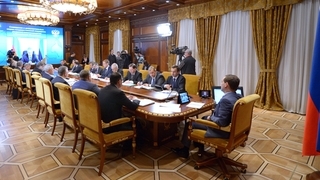Video conference on additional measures of state support for livestock farming
The topic of the teleconference is the current state of animal husbandry and measures for its support, including those taken after Russia joined the WTO.
Participants: Russian Deputy Prime Minister Arkady Dvorkovich, Minister of Agriculture Nikolai Fyodorov, regional heads, representatives of sectorial unions, associations and organisations.
* * *
During the implementation of the State Programme for the Development of Agriculture and Regulation of the Markets of Agricultural Products, Raw Materials and Food for 2008-2012, cattle and poultry production grew by 2.9 million tonnes, or 33%, compared to the 2007 level, totalling 11.63 million tonnes in 2012.
The structure of cattle and bird production changed for different categories of farms over these five years. In 2007, agricultural organisations provided 49.1% of the total volume of cattle and poultry raised for slaughter, household plots accounted for 47.8%, and private farms provided 3.1%. In 2012, agricultural organisations produced 63.5% of the total volume, household plots – 33.1%, and private farms – 3.4%.
Production of poultry for slaughter in live weight in 2008-2012 grew by 2.2 million tonnes, or 82.7%, compared to the 2007 level, to total 4.8 million tonnes in 2012. Agricultural organisations are responsible for the majority of growth in the production of poultry for slaughter, which is 98.7%.
Production of poultry meat developed most actively in the Republic of Tatarstan, the Krasnodar Territory, and the Belgorod, Voronezh, Leningrad, Novgorod, Rostov, and Chelyabinsk regions. Production of pigs for slaughter over the same period expanded by 726,000 tonnes, or 28.1% in live weight. The entire growth in production was achieved by the industry sector.
The main pig production is concentrated in the Central (38% of the total volume), Volga (20%) and Siberian (14%) federal districts. Among Russian entities, the leaders in the production volumes are the Krasnodar Territory, and the Belgorod, Voronezh and Rostov regions.
In 2012, milk production totalled 31.92 million tonnes, or 99.8% compared to the 2007 level. In agricultural organisations, growth in production totalled 4.2%, and 34.1% in private farms. In household plots, it fell by 6.6% compared to the 2007 level.
As part of the implementation of the state programme for 2008-2012, 108.7 billion roubles was allocated for animal husbandry. Over 2,200 facilities were constructed, modernised and launched using advanced technologies, including 272 for poultry meat production, 382 for pork production, 322 for beef farming and 1,240 facilities for dairy breeding.
In all, 12.3 million tonnes of meat of all types in live weight will be produced in 2013, which is 5.8% more than in 2012. Of this volume, 5.3 million tonnes of poultry meat will be produced, which is 9.3% more than in 2012. Production of pork will total 3.5 million tonnes, or 6.3% more, and of milk, 32.5 million tonnes, which is 1.8% more than in 2012.
The current price situation, the growth in prices for feed caused by a rise in the prices of grain fodder, will lead to an essential increase in prime cost and a reduction of profitability of the production of livestock products. Preserving the current situation for an extended period may reduce the investment attractiveness of animal husbandry and the rate of its development.
To preserve the investment attractiveness of animal husbandry and partly to even out negative consequences of the rise in grain prices, it has been proposed to allocate additional funding for the compensation of expenses caused by a rise in fodder prices for organisations engaged in the production of eggs, poultry meat, pork and milk. This should be done during the current year. For these purposes, 15 billion roubles will be allocated in 2013. Dairy breeding requires long-term credit resources. There are plans to expand the period of subsidising investment credits in dairy breeding from eight to fifteen years, and there is a possibility of allocating targeted subsidies from the federal budget on the construction of new dairy breeding facilities.

